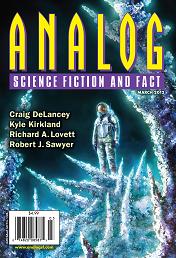 Analog, March 2012
Analog, March 2012
“The Ediacarian Machine” by Craig DeLancey
“Upon Their Backs” by Kyle Kirkland
“Mother’s Tattoos” by Richard A. Lovett
“Ernesto” by Alec Nevala-Lee
Reviewed by Sherry Decker
“The Ediacarian Machine” by Craig DeLancey is worth wading through a slow start. It has three interesting, believable, characters. Karen has discovered an ancient machine buried in the forest. Not simply ancient; it’s prehistoric in the most imposing sense. Ediacarian means “Pre-pre-Cambrian,” when bacteria was at the top and bottom of the food chain. Suspecting she has bitten off more than she can chew alone, Karen contacts an old boyfriend, Steve, the protagonist. Steve has the wisdom to contact a third character, Daltry. Combined, they comprise a somewhat respectable brain trust.
This is where the technical aspects of the story, necessarily, slow things down. It’s handled well, however. As in any good science fiction or horror story, the reader says to himself or herself at some point, I wouldn’t do that. In “The Ediacarian Machine” it’s, I wouldn’t go in there. But of course, they go in.
Adventure makes up eighty percent of this story. But then, it’s not the destination, it’s the journey. It was no surprise that the ending was somewhat ambiguous, because how can we truly comprehend extra-terrestrials, or the science that would allow them here? How can we begin to guess at their motives, especially since this ancient machine has been on earth for such an extreme amount of time? Remember the method of communication in Close Encounters of the Third Kind? Music. In this tale it’s colors.
I thought the writing was strong and the story clever even though the author did resort to one of my less favorite devices of common adverbs. The story held my interest through the last line. I enjoyed it.
“Upon Their Backs” by Kyle Kirkland
An anthropologist discovers an ancient cavern. Inside the cavern are eight humanoid bodies. The bodies are in a state of stasis or coma. After the bodies are moved into a secret lab, two of the ‘hibernators’ get up and walk out, unobserved.
This is how the story of “Upon Their Backs” begins. I suspected a clone story, or a body-snatcher tale. In a way, it was, but in “Upon Their Backs” we have a lot of hypothesis and discussion about what is possible and what is pure speculation. I would rather have had a big juicy dose of wild fiction, even if it stretched the realms of possibility. This story reminds me of one chapter from Jurassic Park where readers had to suffer through a long drawn-out explanation of how it’s possible to splice ancient dinosaur DNA together with frog DNA to create a living dinosaur. The central characters in JP reacted logically – they got up and walked out. While some explanation is necessary, here, much of the science seemed more like the author, having done extensive research, insists the readers appreciate all that research. But I don’t need eighteen pages of techno-hypothesizing between central characters to appreciate the idea of aliens growing humanoid forms. Remember the “show, don’t tell” rule of writing? The reader wants to see them walk and hear them talk. Let’s hear the aliens say what they want, instead of reading it second-hand from a mere walk-on character. I’m obviously not the best reviewer for this story. I do not relish page after page of scientific discussion with a heavy dose of technical. I probably sound harsher than I intend. The idea was good and the writing was better than average but for me it read like home work.
Weak: He looked up at me serenely as I came into the room,
(and) She studied me intensely.
Strong: Security was a job you got into because you were too young to realize what you were getting into.
(and) Truth isn’t affected by how many people believe it.
“Mother’s Tattoos” by Richard A. Lovett is an odd tale. It’s futuristic and involves people wearing tattoos and getting paid for advertising. Some tattoos carry secrets. Some tattoos are communication devices, or spy devices or locaters. The protagonist hates the idea of being poor, so he agrees to work for Homeland Services. He wears tattoos that detect terrorists. The first two pages of “Mother’s Tattoos” are world-building and character-building with little action. The relationships he has with his mother, his employer and his girlfriend lack something crucial. Details. Enthusiasm. Something that makes them feel real. Lacking that results in an absence of concern and empathy from a reader. Naturally, the characters and everything else in this story indicate a bleak future. Readers must translate all the future-tech talk in “Mother’s Tattoos” to get to the story. More than once I snuck ahead to see how many pages remained. Not bad writing – it simply didn’t hold my interest.
“Ernesto” by Alec Nevala-Lee
Weak writing: The woman watched us curiously.
“Damn them,” Ernesto said mildly.
(and) I could make out a line of troops,
Strong: On the surface of the water, the sun was beating down in a long white line.
“Ernesto” begins with the line, A year after the war began. It tells the story of a journalist traveling in Spain, staying at the Hotel Florida in Madrid. Also staying there is a writer he refers to as Ernesto. Hemingway, I presume. They become friends and enjoy debating issues of the day, including interesting historical facts, such as the influence of Fascism on the world. Unfortunately, 75% of this tale is passionless discussion instead of a strong debate. It dealt with theological discussions on religion, faith, miracles and even the spontaneous remission of cancer. Scenes from the countryside and the dialogue were clear, but debating miracle cures versus the body’s natural ability to fight off cancer doesn’t make for entertaining fiction.